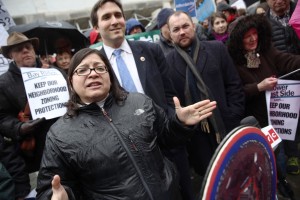
(l to r) Councilmembers Rosie Mendez, Ben Kallos, and Corey Johnson speak at a rally against Mayor Bill de Blasio’s proposed citywide rezoning plan. Image credit: William Alatriste/New York City Council
Speakers argued the plan eliminates residential zoning protections with little affordable housing benefit. On March 25, 2015 the Greenwich Village Society for Historic Preservation held a press conference on the steps of City Hall to protest Mayor Bill de Blasio’s proposed citywide rezoning plan, “Zoning for Quality and Affordability”. According to the Department of City Planning, the plan was created in response to zoning barriers identified by DCP and the Department of Housing Preservation and Development that constrain new housing creation and impede Mayor de Blasio’s Housing New York plan to create and preserve more affordable housing in the city.
The rezoning plan proposes to promote senior housing by permitting mixed configurations of housing types, allowing senior housing and assisted living components inside buildings otherwise designated as market-rate or inclusionary affordable. The plan would also reduce parking requirements for senior and affordable housing near transit, calculating off-street parking costs $20,000 to $50,000 per space to build, and tenants of senior and affordable housing tend to have low rates of car ownership as it is.
Finally, the plan proposes to allow developers to build taller and fully use the maximum FAR of their site, including existing FAR bonuses for building affordable housing units. The plan argues the contextual zoning adopted in 1987 to promote mid-rise housing poorly fits with current building codes, the development of irregularly-shaped sites, and new construction methods such as “block-and-plank” that reduce construction costs but create a fixed maximum building depth. The overall intention is that permitting taller buildings and easing restrictions on maximum FAR development will encourage builders to create buildings with more affordable units and are more visually appealing than box-style buildings constructed to exploit as much FAR as current regulations permit.
This plan drew criticism from elected officials and community groups, who argued the majority of the proposed height and bulk increases for new development would apply to overwhelmingly market-rate or luxury developments. They further argued the height bonuses for inclusionary housing would be granted on an 80/20 model, allowing developers to substantially increase the amount of market-rate units in a building with a minimal gain in affordable units.
At the press conference, Greenwich Village Society for Historic Preservation president Andrew Berman described the proposal as overly favorable to luxury housing developers. “In our neighborhood, as an example, you would get a twenty percent bump just for building luxury condos as compared to what you can currently build, with no public benefit whatsoever. There’s an additional ten percent bump you would get for what the City calls ‘affordable housing’, which is really one unit of affordable housing for every four units of luxury housing built along with it. These thirty percent or more increases the City is proposing for the allowable size of new developments in our neighborhoods are in a best case scenario 80 percent luxury housing with a fraction of affordable housing mixed in.” Simeon Bankoff, president of the Historic Districts Council, opposed the blanket rezoning proposal as ill-suited to a city of diverse neighborhoods. Mr. Bankoff also rejected the premise of the plan that building taller buildings alone would solve the affordability shortage. “Bigger buildings do not equal lower rents. If that were the case, West 57th Street would be Manhattan’s newest middle-class neighborhood. “
Councilmembers Rosie Mendez, Ben Kallos, Inez Barron, and Corey Johnson joined the community groups against the proposed plan. Councilmember Mendez described the long fight to establish contextual zoning as it stands, and objected to the lack of guarantees that the rezoning would substantially increase New York’s affordable housing stock. “If it was all affordable housing, I could go back to my community, and we could try to figure this out. But it’s not going to be affordable housing.” Councilmember Kallos said “What ‘new development’ means is we replace our four-, five-, and six-story walkups that are 100 percent rent-regulated affordable housing with new housing that may have up to 20 percent affordable housing. We will be losing affordable housing, forget about preserving 120,000 units.” Councilmember Kallos also spoke against the use of AMI to calculate affordability of the new units, arguing it is an overbroad number that doesn’t reflect economic realities of the people needing the affordable units. Councilmember Barron spoke to the proposed rezoning of East New York in her district, saying rents for the proposed 3,500 housing units designated affordable are calculated on people earning up to $100,000. “My community, the neighborhood median income is $33,000. …We’re not looking to endorse a plan that won’t provide opportunities for us to continue to live where we have lived all these years.” Councilmember Johnson called for the plan to be fully subject to community input. “We have fifty-nine community boards, we have five boroughs, we have fifty-one members of the City Council. Every neighborhood is different, and to put through a citywide text amendment that will destroy these hard-fought protections is wrong.”
At a meeting with community board representatives on March 31, 2015, Howard Slatkin from the Department of City Planning agreed to provide each of the city’s community boards a breakdown by community district as to how the proposed rezoning would affect the properties in that particular district.
The rezoning plan is open to written public comment. All comments must be received by the Department of City Planning by Monday, April 6, 2015. Members of the public that wish to comment on the rezoning plan may email AHOUSING@planning.nyc.gov, or send letters to:
Robert Dobruskin
Director, Environmental Assessment and Review Division
NYC Department of City Planning
22 Reade Street, 4E
New York, NY 10007
By: Michael Twomey (Michael is the CityLaw Fellow and a New York Law School graduate, Class of 2014)

